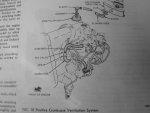I was wandering, explaining how they were originally designed and connected.
The inlet air on my 85 comes from inside the tube feeding air to the throttle body, so is filtered. It connects to the oil filler cap. Air comes in through the tube, through the crankcase, and out via the oil separator on the drivers side of the block, below the intake manifold, thence through a 5/8-3/4 hose, which has the PCV stuffed into it. From the PCV, again into a large hose, turning upward and rearward to the under-side of the upper intake manifold.
All PCV systems need fresh air, a valve, and a port into the intake manifold. Flow is from the fresh air, filtered hopefully, into the crankcase, out, through a PCV to limit flow, and into the intake. Most Fords had a plate, aluminum or fiber, under the carburetor which was fitted with a port to allow PCV fumes to be fed into the engine.
The only image I have of a 2.3 that is close to hand is for a 1974. It shows the PCV tube coming up from below the intake, turning horizontal, and connected to the base of the carburetor on the front side.















